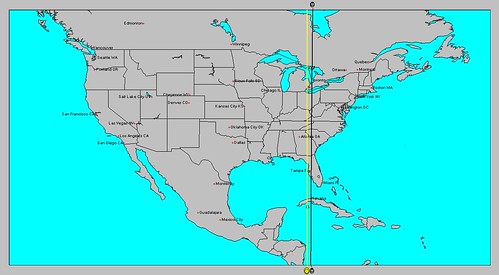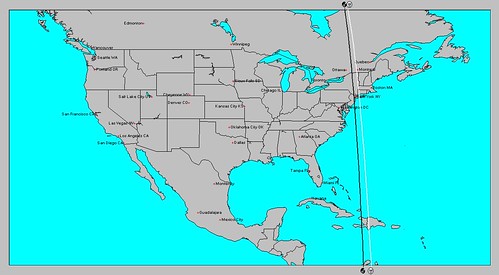Based on a double La Nina followed by an El Nino, Bastardi concludes that "There are things going on that are bigger than the normal course of affairs." He concludes that the trend for coming winters will be toward colder weather. As a result of the La Nina influence,"When the Pacific cools," he states, "the globe cools."
How does Joe's synopsis square away with astro-meteorological indications for future winters? One of the most important tools in astro-meteorology is the Cardinal Solar Ingress chart set for the beginning of each season and valid throughout the entire season in question. Based on indications in the Ingress chart for the winter of 2010-11, I concluded that the U.S. Midwest would experience a cold winter due to the placement of Uranus over the 88th degree of west longitude. This is exactly what is happening.
Since the position of Uranus in an Ingress chart is a good indication of where colder conditions will originate and proceed eastward, it's interesting to note the positions of Uranus in the Cardinal Solar Ingresses for the next three winters. The three maps shown below show where Uranus will be in each seasonal winter chart. I've stripped most of the other planetary lines for ease of viewing.
The first map is for the winter of 2011-12. Here we see the area Uranus will influence shown by the darker line which runs through 82 west longitude or the area from the eastern Great Lakes through Florida. The yellow line next to it shows the Sun's influence which is square to Uranus. This is a disruptive influence resulting in stormy conditions there.

The next map is for the winter of 2012-13. The influence of Uranus affects 74 west longitude that runs through the Northeast U.S. specifically New York and New Jersey.

The third map is for the winter of 2013-14. Here, once again we see Uranus (the white line) affecting the U.S. Northeast. The black line represents the planet Mars, which at that time will be in opposition to Uranus indicating a tempestuous winter season.

The general trend shown here is for the center of cold to migrate progessively eastward over the next few winters. All in all, the eastern U.S. should be in for a few winters comparable to this year's winter. So I think Joe Bastardi is correct in his assesment of future winters. One thing not shown in the above maps is the fact that as we progress toward 2014, Uranus forms a number of squares to Pluto. My research classifies Pluto as a cold planet--thus intensifying the storminess and coldness of the winters to come.
Feb 2-5, 2011 U.S. West Coast and Australia
January 25-27, 2011 New England and Eastern Canada
South Texas Wet Weather Feb 16-18, 2011
Significant West Coast Storm February 20-23, 2011
Major Storm January 3-5, 2011
Midwest Winter Cold and Heating Oil
Tropical Storm Matthew Fulfills Long-range Forecast!
Hurricane Earl and T.D. 10E Fulfill Long-range Forecasts!
Tropical Storm Alex Fulfills Long-range Prediction!
Bonnie Fulfills Long-range Forecast!
Introduction to the Weather Alternative
How Long-Range Forecasts Are Made
SNOW!
I just got off the phone with a friend living in northern North Dakota near the Canadian border. She said that since this morning the snow has been nearly waist high and is still falling. The temperature is dropping way below zero and the north wind is increasing to near gale force. Her husband has done nothing but look through the kitchen window and stare. She says that if it gets worse, she may have to let him in.
3 comments:
Is there an update on why the forecast for the winter of 2011-2012 was so different than forecast? Has the forecast changed for the rest of the future forecast period?
Hi, Ken!
Based on this post, I wrote an article that appeared in the Feb/Mar 2012 edition of The Mountain Astrologer. It carried the same message: colder winters for 2011-14. In the article, I issued specific forecasts for the United States, Europe, and China. I've been posting the results of these forecasts over the last few months. As far as these individual forecasts go, I was quite pleased with their accuracy, but not as far as the cold I expected (along with Joe Bastardi). However, it seems that Europe did have a cold winter to speak of.
It is from these forecasts that don't turn out exactly as expected that a much better understanding of astrometeorology can be gained. The astrometeorologist must start digging to find out what other factor were overlooked. In this case, since Uranus was in key positions over both the States and Europe, why was the European winter colder (more in line with what was forecast) than the North American winter?
So, I wouldn't conclude yet that the forecast for the future periods has changed. It's time for me to start looking at other factors to see if sense can be made out of this passed winter. I'm sure it will provide material for future posts on the subject.
Thank you very much for your informed response. Indeed, Europe was very cold-and snowy this past winter. I look forward to viewing additional forecast that you may post.
Post a Comment